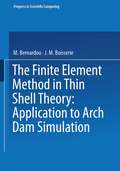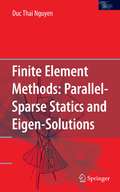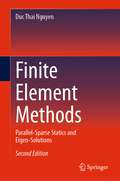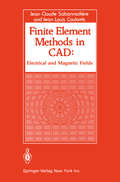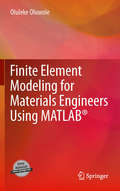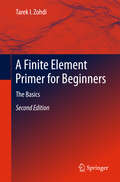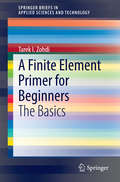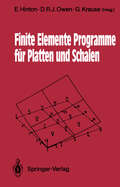- Table View
- List View
A Finite Element Method for Netting: Application to fish cages and fishing gear (SpringerBriefs in Environmental Science)
by Daniel PriourThis book fully describes a finite element method for netting. That describes the relation between forces and deformation of the netting. That takes into account forces due to the twine elasticity, the hydrodynamic forces, the catch effect, the mesh opening stiffness. This book is divided in 5 parts. The first section contains introduction on the finite element method, the second part is about equilibrium calculation, the third presents a triangular element for netting, the fourth and fifth are for cable and node element. The sixth presents few validation cases.
The Finite Element Method in Charged Particle Optics (The Springer International Series in Engineering and Computer Science #519)
by Anjam KhursheedIn the span of only a few decades, the finite element method has become an important numerical technique for solving problems in the subject of charged particle optics. The situation has now developed up to the point where finite element simulation software is sold commercially and routinely used in industry. The introduction of the finite element method in charged particle optics came by way of a PHD thesis written by Eric Munro at the University of Cambridge, England, in 1971 [1], shortly after the first papers appeared on its use to solve Electrical Engineering problems in the late sixties. Although many papers on the use of the finite element method in charged particle optics have been published since Munro's pioneering work, its development in this area has not as yet appeared in any textbook. This fact must be understood within a broader context. The first textbook on the finite element method in Electrical Engineering was published in 1983 [2]. At present, there are only a handful of other books that describe it in relation to Electrical Engineering topics [3], let alone charged particle optics. This is but a tiny fraction of the books dedicated to the finite element method in other subjects such as Civil Engineering. The motivation to write this book comes from the need to redress this imbalance. There is also another important reason for writing this book.
The Finite Element Method in Structural Mechanics: Principles and Practice of Design of Field-consistent Elements for Structural and Solid Mechanics (Solid Mechanics and Its Applications #24)
by Gangan PrathapThis book is not intended to be a text-book, delineating the full scope of finite element methodology, nor is it a comprehensive handbook of modern finite element practice for the finite element engineer. There are enough books that serve to do these and more. It is however intended as a monograph or treatise on a very specific area - the design of robust and accurate elements for applications in struc tural mechanics. It attempts to describe the epistemological conflict between the principles in finite element technology that can be described as Art and those that have a scientific basis invested in it and which can be admitted as science as the subject evolved and came to be accepted. The principles of structural mechanics as a branch of physics are well founded and have a sound scientific basis. The mathematical description of it has also a long history and is rigorously based on the infinitesimal and variational calculus. Of much more recent origin has been the branch of knowledge dealing with the numerical modelling of the beha viour of structural material. The most powerful method available to do this today is the finite element method. It is eminently suited to carry out the entire cycle of design and analysis of a structural configuration on a digital computer.
The Finite Element Method in Thin Shell Theory: Application to Arch Dam Simulations (Progress in Scientific Computing #1)
by Bernardou Boisserie~his Monograph has two objectives : to analyze a f inite e l e m en t m e th o d useful for solving a large class of t hi n shell prob l e ms, and to show in practice how to use this method to simulate an arch dam prob lem. The first objective is developed in Part I. We record the defi- tion of a general thin shell model corresponding to the W.T. KOlTER linear equations and we show the existence and the uniqueness for a solution. By using a co nform ing fi nite e l e m ent me t hod , we associate a family of discrete problems to the continuous problem ; prove the convergence of the method ; and obtain error estimates between exact and approximate solutions. We then describe the impl em enta t ion of some specific conforming methods. The second objective is developed in Part 2. It consists of applying these finite element methods in the case of a representative practical situation that is an arc h dam pro b le m. This kind of problem is still of great interest, since hydroelectric plants permit the rapid increase of electricity production during the day hours of heavy consumption. This regulation requires construction of new hydroelectric plants on suitable sites, as well as permanent control of existing dams that may be enlightened by numerical stress analysis .
Finite Element Method Simulation of 3D Deformable Solids (Synthesis Lectures on Visual Computing: Computer Graphics, Animation, Computational Photography and Imaging)
by Eftychios Sifakis Jernej BarbičThis book serves as a practical guide to simulation of 3D deformable solids using the Finite Element Method (FEM). It reviews a number of topics related to the theory and implementation of FEM approaches: measures of deformation, constitutive laws of nonlinear materials, tetrahedral discretizations, and model reduction techniques for real-time simulation. Simulations of deformable solids are important in many applications in computer graphics, including film special effects, computer games, and virtual surgery. The Finite Element Method has become a popular tool in many such applications. Variants of FEM catering to both offline and real-time simulation have had a mature presence in computer graphics literature. This book is designed for readers familiar with numerical simulation in computer graphics, who would like to obtain a cohesive picture of the various FEM simulation methods available, their strengths and weaknesses, and their applicability in various simulation scenarios. The book is also a practical implementation guide for the visual effects developer, offering a lean yet adequate synopsis of the underlying mathematical theory. Chapter 1 introduces the quantitative descriptions used to capture the deformation of elastic solids, the concept of strain energy, and discusses how force and stress result as a response to deformation. Chapter 2 reviews a number of constitutive models, i.e., analytical laws linking deformation to the resulting force that has successfully been used in various graphics-oriented simulation tasks. Chapter 3 summarizes how deformation and force can be computed discretely on a tetrahedral mesh, and how an implicit integrator can be structured around this discretization. Finally, chapter 4 presents the state of the art in model reduction techniques for real-time FEM solid simulation and discusses which techniques are suitable for which applications. Topics discussed in this chapter include linear modal analysis, modal warping, subspace simulation, and domain decomposition.
The Finite Element Method: Theory, Implementation, and Applications (Texts in Computational Science and Engineering #10)
by Mats G. Larson Fredrik BengzonThis book gives an introduction to the finite element method as a general computational method for solving partial differential equations approximately. Our approach is mathematical in nature with a strong focus on the underlying mathematical principles, such as approximation properties of piecewise polynomial spaces, and variational formulations of partial differential equations, but with a minimum level of advanced mathematical machinery from functional analysis and partial differential equations. In principle, the material should be accessible to students with only knowledge of calculus of several variables, basic partial differential equations, and linear algebra, as the necessary concepts from more advanced analysis are introduced when needed. Throughout the text we emphasize implementation of the involved algorithms, and have therefore mixed mathematical theory with concrete computer code using the numerical software MATLAB is and its PDE-Toolbox. We have also had the ambition to cover some of the most important applications of finite elements and the basic finite element methods developed for those applications, including diffusion and transport phenomena, solid and fluid mechanics, and also electromagnetics.
Finite Element Method to Model Electromagnetic Systems in Low Frequency
by Francis Piriou Stephane ClenetNumerical modeling now plays a central role in the design and study of electromagnetic systems. In the field of devices operating in low frequency, it is the finite element method that has come to the fore in recent decades. Today, it is widely used by engineers and researchers in industry, as well as in research centers. This book describes in detail all the steps required to discretize Maxwell’s equations using the finite element method. This involves progressing from the basic equations in the continuous domain to equations in the discrete domain that are solved by a computer. This approach is carried out with a constant focus on maintaining a link between physics, i.e. the properties of electromagnetic fields, and numerical analysis. Numerous academic examples, which are used throughout the various stages of model construction, help to clarify the developments.
Finite Element Method to Model Electromagnetic Systems in Low Frequency
by Francis Piriou Stéphane ClénetNumerical modeling now plays a central role in the design and study of electromagnetic systems. In the field of devices operating in low frequency, it is the finite element method that has come to the fore in recent decades. Today, it is widely used by engineers and researchers in industry, as well as in research centers. This book describes in detail all the steps required to discretize Maxwell’s equations using the finite element method. This involves progressing from the basic equations in the continuous domain to equations in the discrete domain that are solved by a computer. This approach is carried out with a constant focus on maintaining a link between physics, i.e. the properties of electromagnetic fields, and numerical analysis. Numerous academic examples, which are used throughout the various stages of model construction, help to clarify the developments.
Finite Element Methods: Parallel-Sparse Statics and Eigen-Solutions
by Duc Thai NguyenFinite element methods (FEM), and its associated computer software have been widely accepted as one of the most effective general tools for solving large-scale, practical engineering and science applications. For implicit finite element codes, it is a well-known fact that efficient equation and eigen-solvers play critical roles in solving large-scale, practical engineering/science problems. Sparse matrix technologies have been evolved and become mature enough that all popular, commercialized FEM codes have already inserted sparse solvers into their software. However, a few FEM books have detailed discussions about Lanczos eigen-solvers, or explain domain decomposition (DD) finite element formulation (including detailed hand-calculator numerical examples) for parallel computing purposes. The materials from this book have been evolved over the past several years through the author's research work, and graduate courses.
Finite Element Methods: Parallel-Sparse Statics and Eigen-Solutions
by Duc Thai NguyenThis new edition includes three new chapters, 7 through 9, that have very broad, practical applications in engineering and science. In addition, the author’s latest research results incorporated into the new textbook demonstrates better performance than the popular METIS software for partitioning graphs, partitioning finite element meshes, and producing fill-reducing orderings for sparse matrices. The new Chapter 8, and its pre-requisite, Chapter 7, present a state-of-the-art algorithm for computing the shortest paths for real-life (large-scale) transportation networks with minimum computational time. This approach has not yet appeared in any existing textbooks and it could open the doors for other transportation engineering applications. Chapter 9 vastly expands the scope of the previous edition by including sensitivity (gradient) computation and MATLAB’s built-in function “fmincon” for obtaining the optimum (or best) solution for general engineering problems.
Finite Element Methods and Their Applications (Scientific Computation)
by Zhangxin ChenIntroduce every concept in the simplest setting and to maintain a level of treatment that is as rigorous as possible without being unnecessarily abstract. Contains unique recent developments of various finite elements such as nonconforming, mixed, discontinuous, characteristic, and adaptive finite elements, along with their applications. Describes unique recent applications of finite element methods to important fields such as multiphase flows in porous media and semiconductor modelling. Treats the three major types of partial differential equations, i.e., elliptic, parabolic, and hyperbolic equations.
Finite Element Methods for Engineering Sciences: Theoretical Approach and Problem Solving Techniques
by Joel ChaskalovicThis self-tutorial offers a concise yet thorough grounding in the mathematics necessary for successfully applying FEMs to practical problems in science and engineering. The unique approach first summarizes and outlines the finite-element mathematics in general and then, in the second and major part, formulates problem examples that clearly demonstrate the techniques of functional analysis via numerous and diverse exercises. The solutions of the problems are given directly afterwards. Using this approach, the author motivates and encourages the reader to actively acquire the knowledge of finite-element methods instead of passively absorbing the material, as in most standard textbooks. The enlarged English-language edition, based on the original French, also contains a chapter on the approximation steps derived from the description of nature with differential equations and then applied to the specific model to be used. Furthermore, an introduction to tensor calculus using distribution theory offers further insight for readers with different mathematical backgrounds.
Finite Element Methods in CAD: Electrical and Magnetic Fields
by Jean Claude Sabonnadiere Jean Louis CoulombThe finite element method (FEM) has been understood, at least in principle, for more than 50 years. The integral formulation on which it is based has been known for a longer time (thanks to the work of Galerkin, Ritz, Courant and Hilbert,1.4 to mention the most important). However, the method could not be applied in a practical way since it involved the solution of a large number of linear or non-linear algebraic equations. Today it is quite common, with the aid of computers, to solve non-linear algebraic problems of several thousand equations. The necessary numerical methods and programming techniques are now an integral part of the teaching curriculum in most engineering schools. Mechanical engineers, confronted with very complicated structural problems, were the first to take advantage of advanced computational methods and high level languages (FORTRAN) to transform the mechanical models into algebraic equations (1956). In recent times (1960), the FEM has been studied by applied mathematicians and, having received rigorous treatment, has become a part of the more general study of partial differential equations, gradually replacing the finite difference method which had been considered the universal tool to solve these types of problems.
Finite Element Model Updating Using Computational Intelligence Techniques: Applications to Structural Dynamics
by Tshilidzi MarwalaFEM updating allows FEMs to be tuned better to reflect measured data. It can be conducted using two different statistical frameworks: the maximum likelihood approach and Bayesian approaches. This book applies both strategies to the field of structural mechanics, using vibration data. Computational intelligence techniques including: multi-layer perceptron neural networks; particle swarm and GA-based optimization methods; simulated annealing; response surface methods; and expectation maximization algorithms, are proposed to facilitate the updating process. Based on these methods, the most appropriate updated FEM is selected, a problem that traditional FEM updating has not addressed. This is found to incorporate engineering judgment into finite elements through the formulations of prior distributions. Case studies, demonstrating the principles test the viability of the approaches, and. by critically analysing the state of the art in FEM updating, this book identifies new research directions.
Finite Element Modeling for Materials Engineers Using MATLAB®
by Oluleke OluwoleThe finite element method is often used for numerical computation in the applied sciences. It makes a major contribution to the range of numerical methods used in the simulation of systems and irregular domains, and its importance today has made it an important subject of study for all engineering students. While treatments of the method itself can be found in many traditional finite element books, Finite Element Modeling for Materials Engineers Using MATLAB® combines the finite element method with MATLAB to offer materials engineers a fast and code-free way of modeling for many materials processes. Finite Element Modeling for Materials Engineers Using MATLAB® covers such topics as:developing a weak formulation as a prelude to obtaining the finite element equation,interpolation functions,derivation of elemental equations, anduse of the Partial Differential Equation Toolbox™.Exercises are given based on each example and m-files based on the examples are freely available to readers online.Researchers, advanced undergraduate and postgraduate students, and practitioners in the fields of materials and metallurgy will find Finite Element Modeling for Materials Engineers Using MATLAB® a useful guide to using MATLAB for engineering analysis and decision-making.
A Finite Element Primer for Beginners: The Basics (SpringerBriefs in Applied Sciences and Technology)
by Tarek I. ZohdiThe purpose of this primer is to provide the basics of the Finite Element Method, primarily illustrated through a classical model problem, linearized elasticity. The topics covered are: • Weighted residual methods and Galerkin approximations,• A model problem for one-dimensional linear elastostatics,• Weak formulations in one dimension,• Minimum principles in one dimension,• Error estimation in one dimension,• Construction of Finite Element basis functions in one dimension,• Gaussian Quadrature,• Iterative solvers and element by element data structures,• A model problem for three-dimensional linear elastostatics,• Weak formulations in three dimensions,• Basic rules for element construction in three-dimensions,• Assembly of the system and solution schemes,• An introduction to time-dependent problems and• An introduction to rapid computation based on domain decomposition and basic parallel processing. The approach is to introduce the basic concepts first in one-dimension, then move on to three-dimensions. A relatively informal style is adopted. This primer is intended to be a “starting point”, which can be later augmented by the large array of rigorous, detailed, books in the area of Finite Element analysis. In addition to overall improvements to the first edition, this second edition also adds several carefully selected in-class exam problems from exams given over the last 15 years at UC Berkeley, as well as a large number of take-home computer projects. These problems and projects are designed to be aligned to the theory provided in the main text of this primer.
A Finite Element Primer for Beginners: The Basics (SpringerBriefs in Applied Sciences and Technology)
by Tarek I. ZohdiThe purpose of this primer is to provide the basics of the Finite Element Method, primarily illustrated through a classical model problem, linearized elasticity. The topics covered are:(1) Weighted residual methods and Galerkin approximations,(2) A model problem for one-dimensional linear elastostatics,(3) Weak formulations in one dimension,(4) Minimum principles in one dimension,(5) Error estimation in one dimension,(5) Construction of Finite Element basis functions in one dimension,(6) Gaussian Quadrature,(7) Iterative solvers and element by element data structures,(8) A model problem for three-dimensional linear elastostatics,(9) Weak formulations in three dimensions,(10) Basic rules for element construction in three-dimensions,(11) Assembly of the system and solution schemes,(12) Assembly of the system and solution schemes,(13) An introduction to time-dependent problems and(14) A brief introduction to rapid computation based on domain decomposition and basic parallel processing.
Finite Element Programs for Structural Vibrations
by C.T.F. RossFinite Element Programs for Structural Vibrations presents detailed descriptions of how to use six computer programs (written in Fortran 77) to determine the resonant frequencies of one, two, and three-dimensional skeletal structures through the finite element method. Chapter 1 is on "The Finite Element Method" and Chapter 2 demonstrates, with the aid of hand calculations, the finite element solution of some smaller structures. Chapter 3 covers "The Modular Approach", and Chapters 4 to 9 describe the six computer programs, with a large number of worked examples. The six computer programs are given in Appendices I through VI, and on a 3 1/2'' disk included with the book. The programs are suitable for use on IBM (or compatible) PC (640K or more) or minicomputer.
Finite Elemente: Eine Einführung für Ingenieure
by Klaus Knothe Heribert WesselsDieses gut eingeführte Lehrbuch liegt in überarbeiteter und erweiterter Form wieder vor. Es möchte Studierenden der Ingenieurwissenschaften und Ingenieuren in der Industriepraxis den Einstieg in die Methode der finiten Elemente und das Verständnis großer Programmsysteme für strukturmechanische Aufgaben erleichtern und liefert das notwendige Fachwissen. Zunächst werden Probleme der linearen Statik, Dynamik und Stabilität bei Scheiben, Platten und Stabwerken behandelt. Darüber hinaus werden moderne Erweiterungen angesprochen. Das Buch will den Leser in die Lage versetzen, die Ergebnisse von Simulationsrechnungen kritisch beurteilen zu können sowie seine Fähigkeiten selbst weiterzuentwickeln und zu kontrollieren.
Finite Elemente Programme für Platten und Schalen
by E. Hinton D. R. J. Owen Gerhard KrauseDas Buch geht über die Beschreibung der Methode oder spezieller Programme weit hinaus: Es bietet einen relativ einfachen Zugang, indem lediglich geringe mathematische Vorkenntnisse (Differentialgleichungen und Matrizenrechnung) erwartet und die Voraussetzungen der schubweichen Plattentheorie und einer speziellen Schalentheorie so weit dargestellt werden, wie man sie zum Aufstellen der finiten Gleichungen benötigt. Die hergeleiteten Bezeichnungen sind nicht nur relativ leicht nachvollziehbar, sondern werden in Form von Programmen praktisch vermittelt; die Umsetzung wird an praxisorientierten Beispielen demonstriert. Die Programme können dazu dienen, sie auf eigene Probleme anzuwenden, die Software weiter auszubauen oder aber verfeinerte Algorithmen zu implementieren. Diese Ausgabe ist gegenüber dem englischen Original erweitert und aktualisiert worden.
Finite Elements in Fracture Mechanics: Theory - Numerics - Applications (Solid Mechanics and Its Applications #201)
by Meinhard KunaFracture mechanics has established itself as an important discipline of growing interest to those working to assess the safety, reliability and service life of engineering structures and materials. In order to calculate the loading situation at cracks and defects, nowadays numerical techniques like finite element method (FEM) have become indispensable tools for a broad range of applications. The present monograph provides an introduction to the essential concepts of fracture mechanics, its main goal being to procure the special techniques for FEM analysis of crack problems, which have to date only been mastered by experts. All kinds of static, dynamic and fatigue fracture problems are treated in two- and three-dimensional elastic and plastic structural components. The usage of the various solution techniques is demonstrated by means of sample problems selected from practical engineering case studies. The primary target group includes graduate students, researchers in academia and engineers in practice.
Finite Elements Methods in Mechanics (Solid Mechanics and Its Applications #216)
by M. Reza EslamiThis book covers all basic areas of mechanical engineering, such as fluid mechanics, heat conduction, beams and elasticity with detailed derivations for the mass, stiffness and force matrices. It is especially designed to give physical feeling to the reader for finite element approximation by the introduction of finite elements to the elevation of elastic membrane. A detailed treatment of computer methods with numerical examples are provided. In the fluid mechanics chapter, the conventional and vorticity transport formulations for viscous incompressible fluid flow with discussion on the method of solution are presented. The variational and Galerkin formulations of the heat conduction, beams and elasticity problems are also discussed in detail. Three computer codes are provided to solve the elastic membrane problem. One of them solves the Poisson’s equation. The second computer program handles the two dimensional elasticity problems and the third one presents the three dimensional transient heat conduction problems. The programs are written in C++ environment.
Finite Elements Using Maple: A Symbolic Programming Approach
by Artur Portela A. CharafiThis text provides the reader with a unique insight into the finite element method, along with symbolic programing that fundamentally changes the way applications can be developed. It is an essential tool for undergraduate or early postgraduate courses as well as an excellent reference book for engineers and scientists who want to quickly develop finite-element programs. The use of symbolic computation in Maple system delivers new benefits in the analysis and understanding of the finite element method.
Finite Elements Using Maxima: Theory and Routines for Rods and Beams
by Andreas Öchsner Resam MakvandiThis book provides a study aid on the finite element method. Based on the free computer algebra system “Maxima”, it presents routines to symbolically or numerically solve problems in the context of plane truss and frame structures. This allows readers to not only check classical “hand calculations” but also understand the computer implementation of the method. The mechanical theories focus on the classical one-dimensional structural elements, i.e. bars, Euler–Bernoulli and Timoshenko beams as well as their combination to generalized beam elements. Focusing on one-dimensional elements reduces the complexity of the mathematical framework and the resulting matrix equations can still be displayed with all components, and not only in a symbolic representation. The use of a computer algebra system and the incorporated functions, e.g. for equation solving, highlights the methodology of the finite element method rather than standard procedures.The book is based on the Springer Brief “Finite Elements for Truss and Frame Structures” (978-3-319-94940-6) by the same authors.
Finite Fields: Normal Bases and Completely Free Elements (The Springer International Series in Engineering and Computer Science #390)
by Dirk HachenbergerFinite Fields are fundamental structures of Discrete Mathematics. They serve as basic data structures in pure disciplines like Finite Geometries and Combinatorics, and also have aroused much interest in applied disciplines like Coding Theory and Cryptography. A look at the topics of the proceed ings volume of the Third International Conference on Finite Fields and Their Applications (Glasgow, 1995) (see [18]), or at the list of references in I. E. Shparlinski's book [47] (a recent extensive survey on the Theory of Finite Fields with particular emphasis on computational aspects), shows that the area of Finite Fields goes through a tremendous development. The central topic of the present text is the famous Normal Basis Theo rem, a classical result from field theory, stating that in every finite dimen sional Galois extension E over F there exists an element w whose conjugates under the Galois group of E over F form an F-basis of E (i. e. , a normal basis of E over F; w is called free in E over F). For finite fields, the Nor mal Basis Theorem has first been proved by K. Hensel [19] in 1888. Since normal bases in finite fields in the last two decades have been proved to be very useful for doing arithmetic computations, at present, the algorithmic and explicit construction of (particular) such bases has become one of the major research topics in Finite Field Theory.



